By Brian Hibbs
Some people say Diamond is a monopoly, but I don’t especially subscribe to this view — especially where graphic novel distribution is concerned. Certainly, if you’re talking solely about periodical comics, then, yeah, Diamond is pretty much the only place to buy those, but out in the actual world, periodicals are only about a third of the sales of “comics” as a whole. (This generally matches the pattern of the individual micro-market of my store, too.)
“Graphic Novels” are one of the fastest growing segments of print in general — growing much stronger and faster than “traditional” prose — and they are, in my view, where the actual money of making comics is located. The way I think about it, I brought in two copies of Watchmen in 1989, and turned (and turned and turned and turned) that $20 investment into nearly $13 thousand of sales over the next 30 years, all with exerting extremely little effort. It is reasonably trivial to stock and restock GNs (especially now that we have computers and point-of-sales systems!).
Most “Direct Market” retailers have most of their eggs in Diamond’s basket, but there’s really no obligation to do so inherently, especially when it comes to graphic novels. In point of fact, virtually every book that Diamond stocks is available from multiple sources. Many of which are cheaper (and faster!) than Diamond.

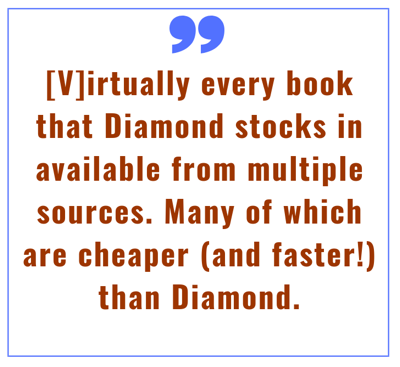
But Diamond has a number of problems, both in vision, as well as in structure. Just to touch the former for a brief moment, ever since signing their first “brokered” deal with DC comics many decades ago, Diamond has increasingly allowed the largest publishers to both shape and limit the expanse of what comics (as a medium) can be. The “Most Favored Nation” clauses of the first DC contract meant that Diamond lost the will (and/or the ability) to promote and grow the “small press.” There was a period in the ’90s where the hegemony of Marvel and DC was being genuinely challenged by the creativity of small- and self-publishers, and, in my view, Diamond entirely ignored the moment. I truly think that the world of graphic novels of today could have come at least a decade earlier if Diamond had actually stepped up then and tried to lead — and they would have owned much more of it than they do today.
Diamond’s structure of how they make money is also a real problem — see, they never made money “just” from the distribution of goods, but also from many policy-level “hidden” charges. For an example: Diamond has a 3 percent “reorder penalty” for, well, reorders. This sort of makes sense when you look back 30+ years when periodicals solely ruled the world. This policy encourages retailers to place periodical orders up front (when you’re going to sell the most product anyway), but when you start applying it to perpetual stock items like books where I’ve sold 300+ times the number of copies of Watchmen over the years than my “initial order,” it begins to make a lot less sense.
Now, this can be sub-rosa for a lot of stores because the “brokered” publishers (Marvel, DC, Dark Horse, Image, Boom!, Dynamite) are paying these fees (or some equivalent) on the retailer’s behalf, but every time a retailer orders, say, a Scholastic book from Diamond, instead of getting the listed 45 percent discount, they’re actually only getting 42 percent. Scholastic, I will remind you, is the #1 publisher (with a bullet!) out in the “real world.”
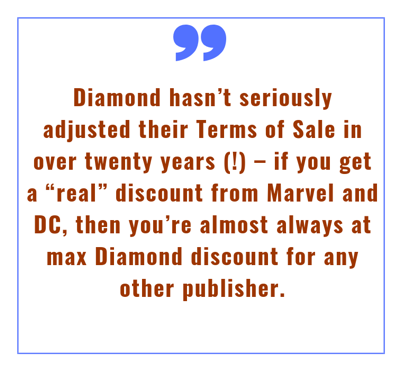
At the end of the day, what I know is that I paid nearly $18 thousand (!!!) to Diamond for shipping in 2018.
Virtually every comics publisher has at least two distribution agreements — one for the “Direct Market” stores with Diamond, and another with the “bookstore” market, and generally speaking for the largest publishers, this agreement is actually with the distribution arm of a larger publisher. DC Comics, for example, is signed both with Diamond as well as with Penguin Random House. Marvel is with Diamond, and Hachette. Boom! and Oni are both with Diamond and Simon & Schuster. Drawn & Quarterly is with Diamond and Macmillan. And so on. Really, the only major exception is Image — Diamond handles both “Direct Market” and “bookstore” distro for Image.
(If you’d like a list of the various distribution options that exist, ComicsPRO has put out a pretty comprehensive list.)
The thing about these “other” distribution options is that they’re as open to “DM” retailers as “bookstores” (those aren’t actually meaningful distinctions in any real world!) — and the joyous thing about a capitalistic world is that any attempt to enforce that kind of distinction would very quickly run up against Restraint of Trade laws. I can choose to buy my DC graphic novels from Diamond, from Penguin Random House, or from any number of lower level wholesalers that exist (say, an Ingram), from whoever I judge best for my business.
But, here’s the thing: a radically increasing percentage of my sales are “books,” and the actual growth in that category is being driven mostly outside the Direct Market system. This is actually the downside of being a “monopoly” — you become dependent on your suppliers, and when your largest ones aren’t firing on all cylinders any longer then you can quickly fall into problems. Marvel’s and DC’s current business models appear to be centered on jamming out as much low-selling product as possible to try and grab rack space in the “frontlist”; this, however, inevitably yields poor-selling trade paperback collections on the “backlist.” Who wants “permanent” reprints of comics that they wouldn’t pay money for serialized?
I’ve been trying to move business where it made sense for a while, but like a lot of retailers, I’m fundamentally overworked as well as kind of stuck in my ways after 30 years. I’d been buying a lot of “small press” from Baker & Taylor for a long time, and trying to using that loss-of-business as a lever to make understand Diamond that they need to be more competitive. It really didn’t work out that way (ha), but I’ve been consistently saving money on “under keystone” type of products because B&T only charged a “Fuel surcharge” of $2.50 flat per shipment, rather than the full freight charges like Diamond. In practice, this worked out to a smidge under 2 percent for shipping, as opposed to the 6 percent or so I pay from Diamond.
Here’s the thing about retail that most of you don’t really know — margins are not great, especially when you’re below the “chain” level, and that 2-4 percent can absolutely make the difference between breaking even on a product and making a profit.
OK, as a “for example”, let’s look at BookScan’s #1 book of the year: Dog Man. It is published by Scholastic, and Diamond has Scholastic as an “F” discount publisher. This means the base discount was 45 percent. BUT, there’s the 3 percent reorder penalty that we talking about, so that drops effective discount to 42 percent. And, as noted, my shipping looks to be 6 percent of wholesale, so my effective discount effectively becomes 36 percent. Or, I could go buy it from Baker & Taylor, where the discount started at 43 percent, but there’s no “penalty” for buying more (!). Shipping is, let’s say, 2 percent, so that take me to 41 percent, BUT there was also a 1.5 percent better discount for paying my monthly statement within 10 days, so it’s now 42.5 percent — a 6.5 percent better discount from the “general” book store distributor as opposed to “the comics specialist.” Man, that’s not nothing, especially over time.
Then, earlier this year, B&T decided this year to stop distributing to retailers. And, as long as I already had to re-source and shake up by purchasing patterns because of that, why not go “all in” and start really looking at these “new” bookstore options that had come up since the last time I paid a lot of attention. I sure could have done this a long time ago, but, y’know “creature of habit” and all that. Change is hard!

But the thing is that that once you’re up to the point where you’re placing rational size reorders (usually as little as just 10 or 20 pieces), it starts becoming absurdly more cost-effective to buy direct from “bookstore” sourcing. Let’s take that example of buying Dog Man — buying non-returnable from Scholastic is a straight 50 percent off cover. Period, the end. And they charge no shipping.
In point of fact, “50 percent off/free shipping” is the bog-standard base deal from basically every bookstore high-level distribution source for non-returnable goods.
So, I can buy Dog Man from Diamond at what comes out for my account as 36 percent off; or I can buy it from Scholastic at 50 percent. That’s a hard choice!
(Also? You usually can’t buy a lot of Scholastic’s output from Diamond anyway. Looking at stock the day I write this, and this is a very typical scenario, but only three of the seven volumes of Dog Man are even in stock in the first place.)
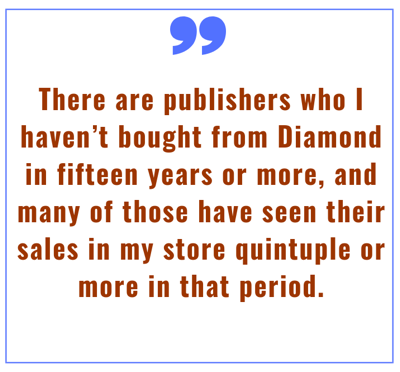
Some might be thinking “Well, OK, but Scholastic is the publisher, of course they can match or beat!” — but it isn’t just pub-owned goods. I mentioned before that Drawn & Quarterly is distributed into bookstores by Macmillan. At Diamond D&Q is (like Scholastic) an “F” discount publisher, so reorders end up only being sold to me at that effective 36 percent. No, it’s 50 percent off and free shipping from Macmillan, which doesn’t have any ownership interest (that I am aware of?) in D&Q.
Boom! and Oni and Viz are all distroed by Simon & Schuster. Both are “E” publishers at Diamond, which is a 50 percent initial discount, but I’m paying shipping on both, and the reorder penalty on the latter — Boom! only gets me an effective 44 percent from Diamond, while Oni and Viz are down to an effective 41 percent. Both are 50 percent off and free shipping from Simon.
Even on the “high-end” of the scale, things can become cheaper once you start taking shipping into account. Penguin Random House handles (among many others) DC and Dark Horse. 50 percent off, and free shipping. Technically, I get a better base discount from Diamond — I am at 55 percent of DC, while Dark Horse book reorders top out at 52.5 percent — but after I deduct the shipping, it sure appears that I am saving around 1 percent on DC and 3.5 percent on DH.
And generally the reorders are arriving 2-4 days faster.
Now, look, for Marvel and DC it’s possible that one’s periodicals discount could drop depending on your volume — DC calculates your discount based on your “rolling six month average orders,” while Marvel does the same over a year (ugh), and these are longer periods of time than are usually easy for us mortals to figure out how things change. It’s actually the one thing that has stopped me from pulling the trigger on moving Marvel over yet. But I’ve been buying my DC trade paperbacks from PRH since the first of the year now, and my frontlist discount is staying steady like a rock. I’ve restocked 22 copies of Watchmen so far from PRH instead of from Diamond, and the sky hasn’t fallen yet. I rather expect I’m going to bite the bullet with Marvel pretty soon.
It is, however, generally impossible to impact your non-“Big two” discounts ± Diamond’s system has preposterously low minimum orders (which, by the way, keep “buying clubs” operating and undercutting regular brick-and-mortar retail), and virtually everyone is “grandfathered” in anyway. Diamond hasn’t seriously adjusted their Terms of Sale in over 20 years (!) — if you get a “real” discount from Marvel and DC, then you’re almost always at max Diamond discount for any other publisher.
There are lots of other reasons to potentially buy from multiple sources — one nice one might be that Diamond is notoriously tight with credit terms, while the bookstore industry appears to understand that net 30 is a pretty minimum repayment cycle (did I mention that several have a better discount if you were to pay faster?); or just the notion that it’s a very good business idea to not have all of your eggs in a single basket? I know stores that are happier with returnable goods at the lower discount (yikes, not for me!), some that recognize Diamond’s slowness to change stocking levels (like the Dog Man example above — it is super common for Diamond to be OOS on commercial books, because they don’t fit into the “boxes” Diamond has built for itself), some that like getting the free point-of-purchase displays, etc etc. There are a dozen reasons to look for other sources outside raw pricing. But pricing is a pretty great motivator!
There are some downsides: there is a non-zero cost at having to write multiple checks each month, for keeping straight where you’re buying from and whom (though much of that is mitigated with a solid Point-of-Sale system that doesn’t “lock you into” Diamond — for example, Diamond didn’t exactly make it easy to have multiple sources if you’ve chosen the Diamond-built ComicSuite), and I will be honest that bookstore packing, which appears to be more generally aimed at fully returnable accounts, can be desultory at best, not really understanding the DM impulse for having “mint” product (Scholastic, in particular, likes using boxes that are the lightest grade of cardboard I’ve even encountered — but I’ve never found any significant source that isn’t equally good at credit-generation or replacement-shipping.
Distribution is changing, the market-for-books is changing, the breadth and width of the audience and what they want is changing — and so how and where retailers buy their stock is naturally changing as well. I personally live in a world of rents and labor costs such that margin is rapidly becoming the single most-important consideration of all.
Distribution terms are at least 20 years out of date at Diamond, so it’s no real surprise that stores are quietly starting to switch their business away from them in increasing numbers. There are publishers who I haven’t bought from Diamond in 15 years or more, and many of those have seen their sales in my store quintuple or more in that period. But how could Diamond know? (I mean, other than me and other retailers physically telling them every year) My point is that Diamond is clearly not selling 100 percent of what the Direct Market stores are selling, and there are days I believe that it could easily be a third or more of the DM-sold comics are not sourced in any way from Diamond itself.
The more you know.
Brian Hibbs has owned and operated Comix Experience in San Francisco since 1989, was a founding member of the Board of Directors of ComicsPRO, has sat on the Board of the Comic Book Legal Defense Fund, and has been an Eisner Award judge. Feel free to e-mail him with any comments. You can purchase two collections of the first Tilting at Windmills (originally serialized in Comics Retailer magazine) published by IDW Publishing, as well as find an archive of pre-CBR installments right here. Brian is also available to consult for your publishing or retailing program.





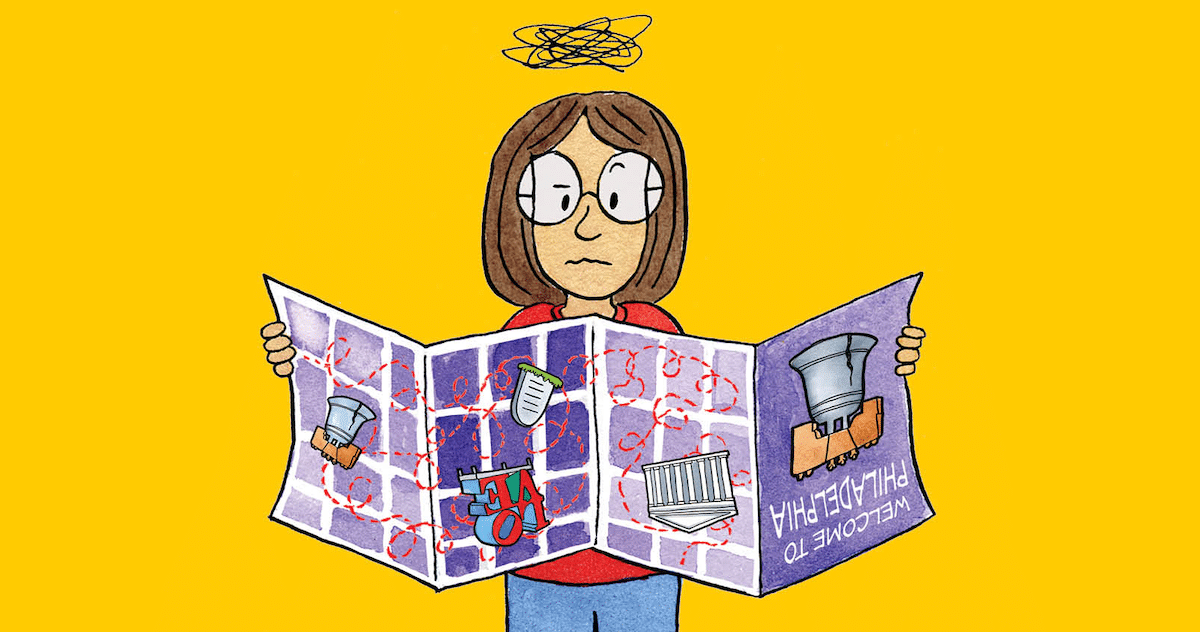
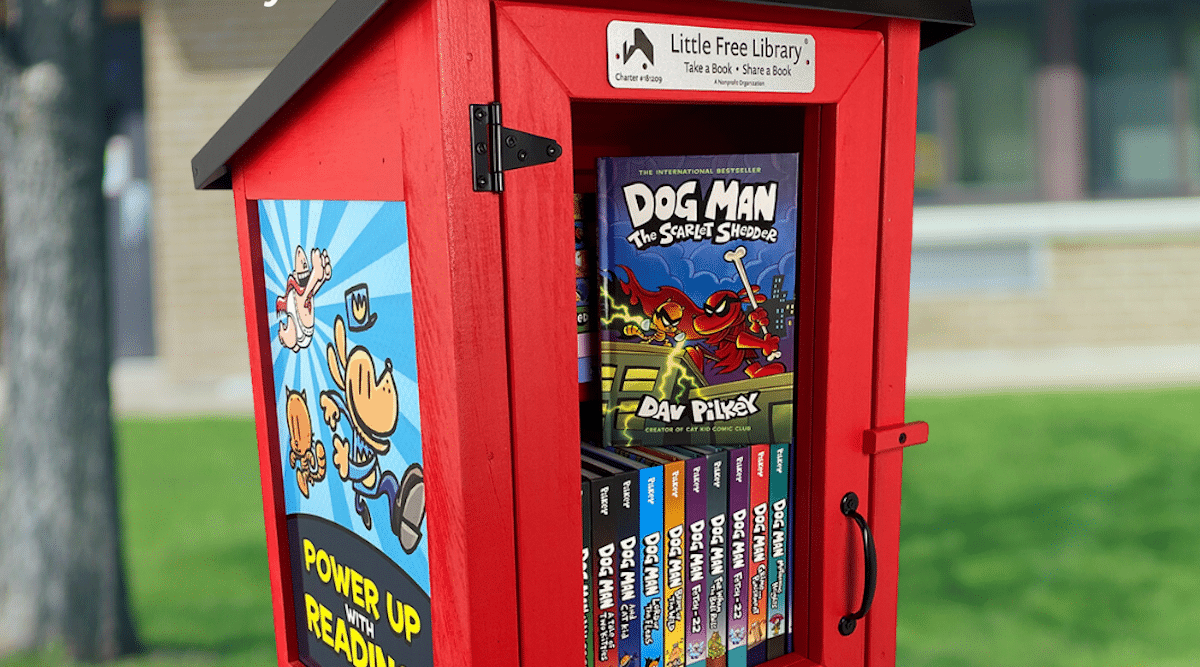


I’ve been looking at channel bleed (as some call it) for some time, and we’ve been considering ways to track its impact in our annual report. It’s not easy to arrive at a number, that’s for sure.
I doubt it’s anywhere near a third of DM sales — many owner-operator shops are Diamond-only just because of the bookkeeping involved, and we also know the comics category at Diamond is twice the size of its GN category, dollarwise. But it is likely significant, contributing to the fact that the category’s been underperforming comics there in recent years.
This is the kind of thing I’ll never understand as a reader of comics, but I sure appreciate that people like Brian Hibbs exist in this world to preach sanity and financial common sense to their fellow retailers. I love comics, and I love my comic shop. If reading Hibbs’ articles can keep shop owners in business for a long time, I say keep on preaching!
Its probably not actually a third of the market… but there are days I believe it could be.
-B
Yeah, I got that. My guess is we have at least $10M currently in our Book Channel – Non/Bookscan subcategory that belong in the DM, but how much more than that there is I can’t guess.
Brian, if even near of a third of book sales are taking place outside of Diamond, doesn’t that mean that, potentially, publishers are really shooting themselves in the foot limiting their periodicals to Diamond only? Now that comics are viewed in such a more open minded way by the mainstream, do you think one of the larger companies would be potentially interested in distributing the periodicals? Or would it be more trouble than it’s worth? On the other foot, would the large comic publishers not have an interest because the other distribution options wouldn’t put up with the nonsense Diamond bends over for? To me, competition ALWAYS raises the bar and I think it was a HUGE hit to the industry to be locked down to Diamond all those years ago.
Luke, I don’t think that there physically IS any other national distributor that could handle shipping periodicals to the demands and standards of the Direct Market. I’d love to be proven wrong And, generally, the “bookstore” market hasn’t had much success selling periodicals because of how labor intensive and knowledge-needed they are.
-B
My LCS is half games, half comics. We use multiple game distributors, as well as a local warehouse for bags, boards, boxes (cards and comics).
Comics…it’s all Diamond. Our primary focus is on back issues, not trades, although we have a good amount of shelf space.
With B&T ignoring the little guy, what does Ingram offer? (And how soon before Amazon enters that market?)
Comments are closed.